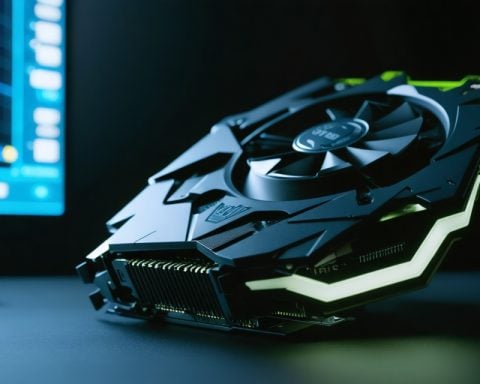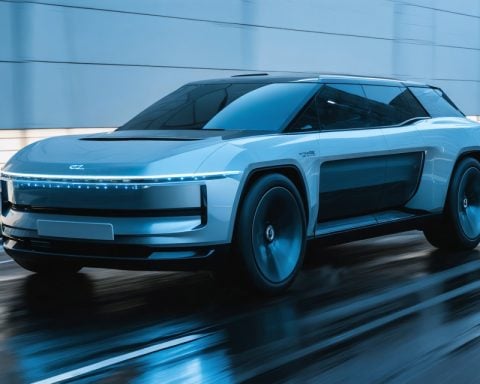- Nvidia’s H20 chip is central to a tech boom in China, driven by high demand from major companies like Tencent, Alibaba, and ByteDance.
- Despite U.S. export restrictions, the H20 chip offers a tailored AI solution for the Chinese market, fostering industry-wide integration.
- DeepSeek, an innovative startup, amplifies this growth by offering budget-friendly AI models that require less computing power.
- Companies can now integrate AI into diverse sectors, such as healthcare and education, overcoming previous cost barriers.
- Possible future U.S. export controls could impact the supply of H20 chips in China, but demand remains robust.
- Nvidia expects significant earnings growth due to the H20’s popularity, indicating a deepening reliance on AI solutions.
Nvidia’s H20 chip is igniting a technological fervor in China, capturing the attention of industry titans and emerging startups alike. This artificial intelligence marvel, tailored for the Chinese market amidst stringent U.S. export restrictions, is suddenly at the heart of an unforeseen boom. The catalyst? An innovative startup named DeepSeek, whose budget-friendly AI models are revolutionizing the landscape.
Inside China’s tech corridors, companies like Tencent, Alibaba, and ByteDance have massively ramped up their orders for the H20. These tech behemoths aren’t just sourcing the chips to bolster internal operations. They are setting the stage for an ecosystem where advanced AI capabilities will become accessible to a broad spectrum of sectors, from healthcare to education.
The secret to DeepSeek’s allure lies in its models, which draw powerful insights—without demanding the brute computing power that rival Western systems require. This efficiency-focused approach enables companies to integrate AI into everyday functionalities seamlessly, catering to industries previously limited by cost and capability.
Meanwhile, the specter of potential U.S. restrictions looms. The current administration is contemplating tighter controls, which could stifle the H20’s flow into China. Yet, the fervent demand suggests this is no mere buying spree prompted by fear of shortages. It’s a testament to the growing dependency on AI-driven solutions.
As Nvidia anticipates reporting substantial earnings, bolstered by the H20’s surging demand, tech pundits wonder about the future synergy between Chinese enterprises and AI innovations. The message is clear: as AI threads its way through the fabric of modern technology, there’s no turning back.
Unveiling the Future of AI: How Nvidia’s H20 Chip is Revolutionizing Technology in China
The Rise of Nvidia’s H20 Chip in China
Nvidia’s H20 chip has sparked a technological revolution in China, becoming a critical element in the rapidly evolving AI landscape. This chip was specifically designed to meet the needs of the Chinese market, particularly in light of U.S. export restrictions. Nvidia’s strategic release of the H20 comes at a pivotal moment, as significant demand drives innovation across various Chinese industries.
How-To Steps & Life Hacks: Leveraging the H20 in Industry
1. Identifying Needs: Companies must assess their existing systems to determine how AI can optimize operations. This involves recognizing key areas where AI can automate tasks, improve efficiency, or provide enhanced analytics.
2. Integration Strategy: Develop a clear plan for integrating the H20 chip into current infrastructures. Consider how the chip’s features can be leveraged to meet specific goals, such as reducing energy consumption or enhancing processing speed.
3. Deployment: Begin with pilot projects to test AI models within operational contexts, ensuring the H20 chip functions as expected under real-world conditions before full-scale implementation.
4. Training and Development: Provide teams with the necessary training to manage and deploy AI technologies effectively. Host workshops and seminars to keep personnel informed about the latest developments.
5. Monitoring and Adjustment: Continuously monitor AI performance and make necessary adjustments to improve outcomes. Use feedback to fine-tune and enhance system capabilities.
Real-World Use Cases
– Healthcare: AI models powered by the H20 are being used to devise personalized treatment plans and expedite diagnostics, leading to better patient outcomes.
– Education: In classrooms, AI tailors learning experiences to individual students; leveraging H20’s capabilities allows for smarter, interactive educational tools.
– Finance: The chip’s processing power enhances real-time analytics and risk assessment, crucial for managing fast-paced financial environments.
Market Forecasts & Industry Trends
The AI hardware market in China is projected to grow exponentially. According to a report from Mordor Intelligence, the AI chip market is expected to reach over $22 billion by 2026, fueled by increased investments and technological advancements like the H20.
Reviews & Comparisons
Experts assert that while the H20 excels in efficiency and cost-effectiveness, it faces stiff competition from other high-performance chips like the Google TPU and AMD’s AI processors. Each offers unique advantages, but Nvidia’s H20 stands out for its adaptability in constrained markets.
Controversies & Limitations
One prominent concern is the geopolitical tension surrounding the U.S. export restrictions, which may limit the availability of the H20 in China. This uncertainty poses risks to long-term dependency on such technology.
Security & Sustainability
Security remains paramount. Nvidia ensures that the H20 incorporates advanced encryption and security protocols to protect data integrity. On sustainability, the chip is designed for energy efficiency, reducing the carbon footprint of advanced computing processes.
Insights & Predictions
The insatiable demand for AI solutions, bolstered by chips like the H20, is anticipated to persist. We’re likely to witness a deeper integration of AI across sectors, progressively impacting everyday life, from smart homes to autonomous vehicles.
Pros & Cons Overview
Pros:
– Cost-effective
– High efficiency
– Adaptability to existing systems
Cons:
– Potential supply limitations
– High dependency on a single technology
Actionable Recommendations
1. Adopt and Innovate: Companies should adopt H20 and consider creative ways to utilize its capabilities.
2. Diversify AI Suppliers: To mitigate risk, diversify tech partners and suppliers beyond a single chip solution.
3. Stay Informed: Keep abreast of geopolitical developments affecting technology imports and exports.
By adopting Nvidia’s H20 chip, businesses in China are at the forefront of an exciting AI transformation. For more information on Nvidia’s technology and potential AI advancements, visit Nvidia.



















